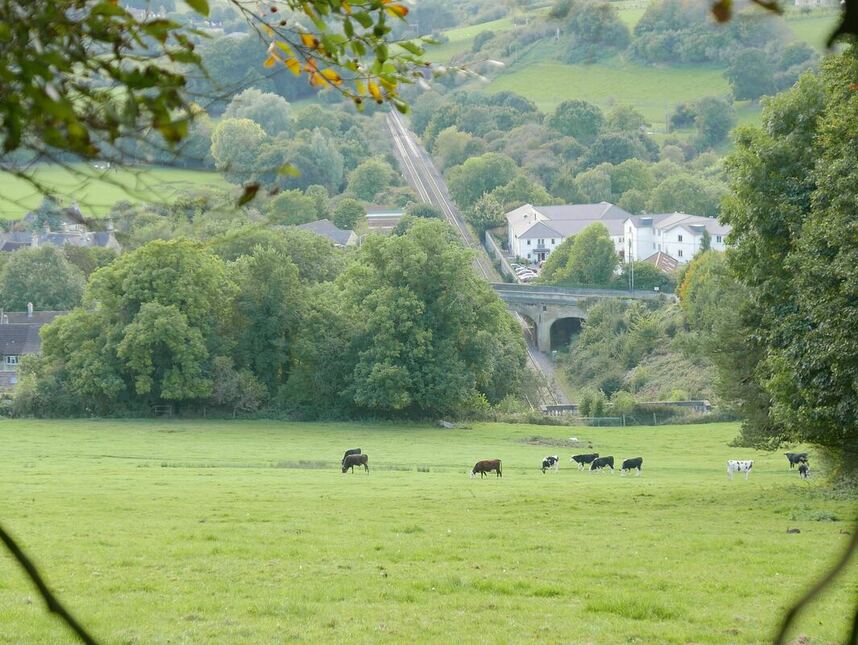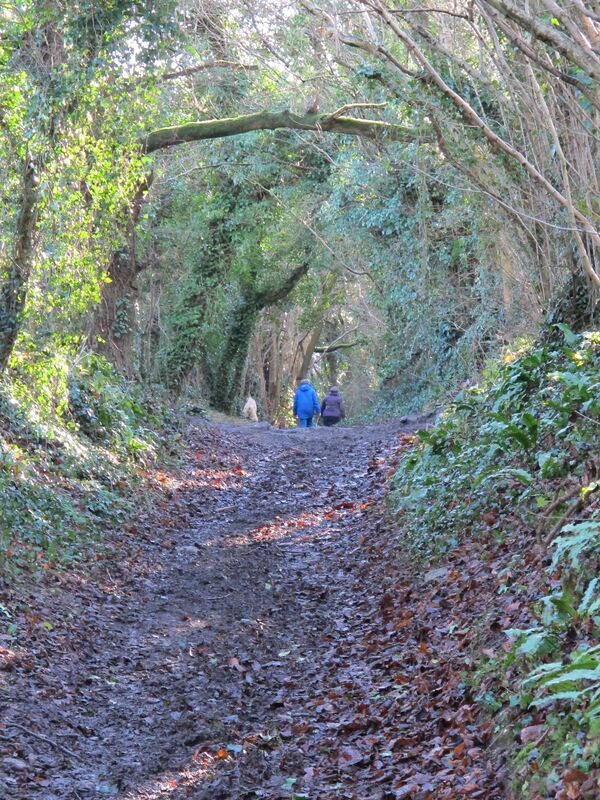Saxon Footpaths Original words 1970 by Richard Hodges Republished August 2018
Photographs courtesy Carol Payne
Photographs courtesy Carol Payne
Bargates and Saxon Fields
I would suggest that you begin from the London Road at the Bassetts and follow the footpath up above the Tunnel, you can then see the ornate work at the head of the tunnel and look down the track to the Wharf where Box Stone was once brought by tram-rails from the mines on the top of the hill. We tend to forget as we look at the tunnel that over a hundred men lost their lives while constructing it and adding to Brunel's fame.
I would suggest that you begin from the London Road at the Bassetts and follow the footpath up above the Tunnel, you can then see the ornate work at the head of the tunnel and look down the track to the Wharf where Box Stone was once brought by tram-rails from the mines on the top of the hill. We tend to forget as we look at the tunnel that over a hundred men lost their lives while constructing it and adding to Brunel's fame.
The pillbox opposite the tunnel parapet was there in Richard's time but not George Lacey's Millennium Woods or Carol Payne's stone sculpture.
At the top of this hill you get a very good view of the village and it is easy to watch the football being played on the recreation ground from here. You clamber over the large stone stile and walk up the road a little way before turning into the Beech Woods; whichever way you walk through these woods you cannot fail to be impressed by the charm of the beeches in spring and autumn. Unfortunately, the quarries have spoiled the woods more especially since filling in operations have commenced. The quarries have provided homes for foxes and bats, and tramps have resided there on several occasions. It is quite a fine wood, really, and you may easily see Nuthatches, Tits, Tree Creepers and once I saw a rare Flycatcher in a secluded part of the wood.
At the end there is a little triangular field where a carthorse once lived. If you go through this, over the stile and then turn right you will be walking along the ridge which commands Box. Before you turn right, if it is late evening, glance around the field on your left, often, especially after the harvest, you may see a fox cross the field just visible in the half light. The ridge field is long and you will almost certainly be feeling the force of the westerly wind before you reach the other end, where you should turn left for Hazelbury Manor.
At the end there is a little triangular field where a carthorse once lived. If you go through this, over the stile and then turn right you will be walking along the ridge which commands Box. Before you turn right, if it is late evening, glance around the field on your left, often, especially after the harvest, you may see a fox cross the field just visible in the half light. The ridge field is long and you will almost certainly be feeling the force of the westerly wind before you reach the other end, where you should turn left for Hazelbury Manor.
Hazelbury Manor
There is a grass track running through the corn fields to the Manor. You pass through a stile and then continue on to what appears like a courtyard, the barn with its asbestos roof is on your right, so is the empty pond and the stables, You are bound to look through the large gates at the magnificent house at the end of the path. If you look around you will notice that there are several separate houses which have little courtyards themselves, as was common in mediaeval times. This was in fact once a mediaeval village; now it is a Girl's School (now private house again). In the fields behind, a Roman tessellated pavement was found indicating that a Roman villa was the earliest occupant of the site. The Manor was recorded in the Domesday Book, but looked different then from that of today which is a mixture of several periods. The Manor is well situated in a hollow, hidden from everywhere, except Kingsdown - this is a typical feature of Roman Villa sites.
There is a grass track running through the corn fields to the Manor. You pass through a stile and then continue on to what appears like a courtyard, the barn with its asbestos roof is on your right, so is the empty pond and the stables, You are bound to look through the large gates at the magnificent house at the end of the path. If you look around you will notice that there are several separate houses which have little courtyards themselves, as was common in mediaeval times. This was in fact once a mediaeval village; now it is a Girl's School (now private house again). In the fields behind, a Roman tessellated pavement was found indicating that a Roman villa was the earliest occupant of the site. The Manor was recorded in the Domesday Book, but looked different then from that of today which is a mixture of several periods. The Manor is well situated in a hollow, hidden from everywhere, except Kingsdown - this is a typical feature of Roman Villa sites.
|
Go through the large pillars and on up the drive to Chapel Plaster. The delightful little Chapel here is very old and always reminds me of Chaucer's Canterbury Tales, supposedly once being a pilgrim chapel with an inn next door. The best way back is across Wadswick Common where once the gypsies used to camp, to the beginning of Wyres Lane at the right-hand corner of the field. Wyres Lane was an old coach road to Box used in the eighteenth century and mostly paved; it joined Box to the London to Bath Road which went past Chapel Plaster across Kingsdown.
|
Now shrubs have cut the size of the road but there is a good clear path. It is very straight and it is easy to find a large variety of shrubs along its course, overall there are Hawthorns, Dog Roses and Spindle whose berries stand out in autumn; flora abounds amongst the hedges and pheasants will often spring out suddenly, being well hidden in the leaves.
After the first long stretch you can gaze across at the Manor and gain a fine idea of Its situation. The lane is steep and you may wonder how a carriage ever climbed up there. Fortunately, you are descending. The path is arched by high trees and a steep bank in which live several rabbits, foxes live in the woods on your left and in Spring the wood is full of anemones and bluebells. Long tailed tits, woodpeckers and wrens are quite common in this overgrown copse. The path bends to the right under the elders. Often it is muddy here but you should manage easily. When it becomes clear, if you look over the wall on your right you will see an old wooden hand sluice-gate to regulate the little stream which has almost become lost in weeds. The stream had to fill a sheep dip further down.
After the first long stretch you can gaze across at the Manor and gain a fine idea of Its situation. The lane is steep and you may wonder how a carriage ever climbed up there. Fortunately, you are descending. The path is arched by high trees and a steep bank in which live several rabbits, foxes live in the woods on your left and in Spring the wood is full of anemones and bluebells. Long tailed tits, woodpeckers and wrens are quite common in this overgrown copse. The path bends to the right under the elders. Often it is muddy here but you should manage easily. When it becomes clear, if you look over the wall on your right you will see an old wooden hand sluice-gate to regulate the little stream which has almost become lost in weeds. The stream had to fill a sheep dip further down.
You come to a crossroad very shortly; if you turn right you return to the Manor passing a pond on your left.
|
Wyres Lane Saxon Track
If you turn left you go down through Box Bottoms, where butterflies are extremely common in summer, especially Peacocks and Red Admirals. You will pass the sheep dip hidden in young elms; on your left directly opposite in the wood is a little clear spring, where wrens, rabbits and badgers come to drink. If you follow the path down you pass through a little plantation and an avenue of shrubbery full of wild life, before you come to the road opposite the Ross Warehouse (now the Industrial Estate) in the Ley. If you had gone straight on up the hill you would have climbed slowly through the arched hawthorns to the pinnacle of the hill, passing an old barn, a well-hidden badger sett and several rabbit warrens on the way. Then you descend, eventually coming down the tarmac’d Hazelbury Hill. But before you leave the avenue of hazels you can easily see the old limestone paving of the coach road. It is a tough pull up there, and again you must be thankful that you are descending, this time into the village. Items in italics not included in 2018 walk. |



